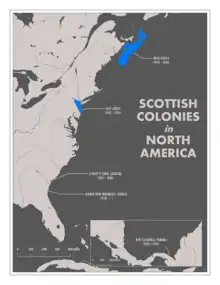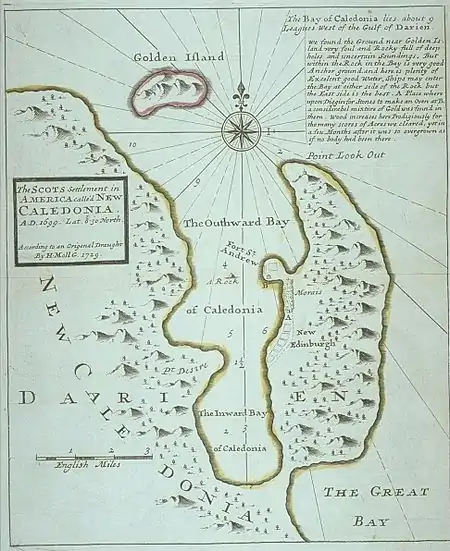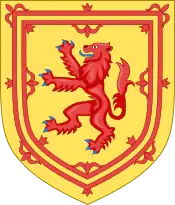Scottish colonization of the Americas
Scottish colonisation of the Americas comprised a number of failed or abandoned Scottish settlements in North America; a colony at Darien on the Isthmus of Panama; and a number of wholly or largely Scottish settlements made after the Acts of Union 1707, and those made by the enforced resettlement after the Battle of Culloden and the Highland Clearances.

| Part of a series on |
| European colonization of the Americas |
|---|
.svg.png.webp) |
|
|
Nova Scotia (1621)
The first documented Scottish settlement in the Americas was of Nova Scotia in 1629. On 29 September 1621, the charter for the foundation of a colony was granted by James VI of Scotland to Sir William Alexander.[1] Between 1622 and 1628, Sir William launched four attempts to send colonists to Nova Scotia; all failed for various reasons. A successful occupation of Nova Scotia was finally achieved in 1629. The colony's charter, in law, made Nova Scotia (defined as all land between Newfoundland and New England; i.e., The Maritimes) a part of mainland Scotland; this was later used to get around the English navigation acts.
Due to difficulties in obtaining a sufficient number of skilled emigrants, in 1624, James VI created a new order of Baronets; admission to this order was obtained by sending six labourers or artisans, sufficiently armed, dressed and supplied for two years, to Nova Scotia, or by paying 3,000 merks to William Alexander. For six months, no one took up this offer until James compelled one to make the first move. In 1627, there was a wider uptake of baronetcies, and thus more settlers available to go to Nova Scotia.
During the Anglo-French War, under Charles I, by 1629 the Kirkes took Quebec City, Sir James Stewart of Killeith, Lord Ochiltree planted a colony on Cape Breton Island, Nova Scotia at Baleine, and Alexander's son, William Alexander, 1st Earl of Stirling established the first incarnation of "New Scotland" at Port Royal, Nova Scotia. This set of British triumphs which left Cape Sable as the only major French holding on mainland Nova Scotia was not destined to last.[2] Charles I's haste to make peace with France on the terms most beneficial to him meant that the new North American gains would be bargained away in the Treaty of Suza and the Treaty of Saint-Germain-en-Laye.[3] The Scots were forced to abandon their Nova Scotia colony in its infancy.[4] The French under Isaac de Razilly reoccupied Nova Scotia (Acadia) in 1632, establishing their new capital at LaHave. Upon Razilly's death, his lieutenant Charles de Menou d'Aulnay moved the capital to the old Scottish settlement of Charles Fort and renamed it Port Royal. (This is not the same Port Royal established by the French in 1605.)
During this time when Nova Scotia briefly became a Scottish Colony, there were three battles between the Scots and the French: one at St. John; another at Cape Sable Island; and the other at Baleine, Nova Scotia.
Cape Breton (1625)
In 1625 a charter was given by James VI for a settlement at Cape Breton, New Galloway. However, this land was never colonised likely due to the problems over the settlement of Nova Scotia.
East New Jersey (1683)
On 23 November 1683, Charles II granted a charter for the colony of New Jersey to 24 proprietors, 12 of whom were Scots. The colony was to be split between an English settlement in West Jersey and a Scottish settlement in East Jersey. The driving force among the Scots was Robert Barclay of Urie,[5] a prominent Quaker and the first Governor of East Jersey.
Although the Quakers were an important force, making up all of the proprietors of East Jersey, the settlement was marketed as a national, rather than a religious, endeavour, partially due to persecution of the Quakers in the 1660s and 1670s.
Scots began arriving in East Jersey in 1683 at Perth Amboy and spread south to Monmouth County. The city became the provincial capital in 1686.[6] During the 1680s, around 700 Scots emigrated to East Jersey, mostly from Aberdeen and Montrose, and around 50% of those travelled as indentured servants. From 1685, there was further emigration, albeit unsought by the emigrants, with the deportation of captured Covenanters. They were originally to have been placed in indented servitude on arrival; however, they were declared by the courts to be free men, as they had not voluntarily indented. In the 1690s, the pace of Scottish immigration slowed, due to opposition by William III of England and II of Scotland to those proprietors who supported James II of England and VII of Scotland; it did not pick up again till the 1720s. The initial immigrants to East Jersey were Quakers, Episcopalians and Presbyterians; by the 1730s, Presbyterianism had become the dominant religion.
Until 1697, every Governor of East Jersey was Scottish, and Scots maintained great influence in politics and business even after 1702, when East Jersey and West Jersey were merged to become a Royal Colony.
Stuarts Town, Carolina (1684)
Although the Province of Carolina was an English colony in the early 1680s, Sir John Cochrane of Ochiltree and Sir George Campbell of Cessnock negotiated the purchase of two counties for Scottish settlement. These were intended, with the support of the Earl of Shaftesbury, the leader of the Carolina Proprietors, to provide a haven for Covenanters, as these Scots negotiated a guarantee of freedom of conscience and autonomous control of their colony,[7]:31–32 which extended from Charles Town towards Spanish territory.
In 1684, 148 Scots settlers arrived from Gourock to build a settlement at Port Royal, the site of former French and Spanish settlements. This was renamed by the Scots as Stuarts Town.[7]:39
Once settled, there was frequent conflict, both with Spanish-allied Indians and with the English at Charles Town, the latter over English attempts to assert authority over the Scots and rights to the lucrative Indian trade. The Scots also carried out frequent raids on Spanish allied Indians and raided the Spanish mission at Santa Catalina de Guale as well as encouraging (and arming) their Yamasee trading partners to attack the Spanish directly. In August 1686, the Spanish retaliated and sent three ships with 150 Spanish troops and Indian allies to attack Stuarts Town.[7]:47 Due to a recent sickness, the Scots had only 25 effective fighting men able to mount a defence and the town was wiped out.[8] There was no retaliation by the English, who were warned by the Proprietors not to interfere.
Darien Scheme (1695)

The Darien scheme is probably the best known of all Scotland's colonial endeavours, and the most disastrous. In 1695, an act was passed in the Parliament of Scotland establishing The Company of Scotland Trading to Africa and the Indies and was given royal assent by the Scottish representative of King William II of Scotland (and III of England). This act gave the company a 31-year monopoly on trade with Africa and Asia, authorising it to arm and equip ships and to establish colonies in uninhabited or unclaimed areas of America, Asia or Africa. These powers were similar to those of the English East India Company, which opposed the establishment of a Scottish rival.
Capital for the company of £400,000 (estimated at one-quarter to one-third of the liquid wealth of Scotland) was raised solely in Scotland, due to intrigue by English merchants and the English government which prevented shares being sold in Amsterdam and Hamburg.[9] This opposition also prevented shares being sold in England, as was the original intention.
In 1696, 2,500 Scottish settlers, in two expeditions, set out to found a Scottish trading colony at Darién on the isthmus of Panama. These settlers were made up of ex-soldiers, ministers of religion, merchants, sailors and the younger sons of the gentry, to receive 50 to 150 acres (0.61 km2) each. The government of the colony was run by a committee, the chairman of which changed every two weeks.
The problems faced by the settlers included a lack of provisions due to famine in Scotland, the Scots' lack of colonising experience, diseases such as malaria, poor weather and the proximity of the Spanish, who claimed the land the Scots had settled on. Also, for a trading colony established to trade with passing ships in both the Pacific and Atlantic Oceans, they carried a poor choice of trade goods, including wigs, shoes, bibles, woolen clothing and clay pipes.
The colony received no assistance from the crown or English colonies in the West Indies or Jamaica, despite having been promised, in the 1695 act, the assistance of William II. Thus, the Scots faced assaults by the Spanish on their own. In 1699, they dealt with this by recruiting a Jamaican captain to raid Spanish shipping as a privateer, but this achieved little. Soon thereafter, the Spanish mounted an expedition of 500 men to wipe out the Scots. This was effective, as most settlers had already succumbed to disease or starvation.
The company also took control of Crab Island in 1698 (modern day Vieques, Puerto Rico), yet sovereignty was short lived.
Darien, Georgia (1735)
Darien, Georgia, was a settlement created by Englishman James Oglethorpe and his aide Captain George Dunbar who brought in 177 Scots settlers to the Province of Georgia. It was named after the previous failed settlement on the Isthmus of Panama, though it was, for a time, also known as "New Inverness".[10]
See also
Part of a series on the |
|---|
| History of Scotland |
 |
|
|
References
- Fry, Michael (2001). The Scottish Empire. Tuckwell Press. p. 21. ISBN 1-84158-259-X.
- Roger Sarty and Doug Knight. Saint John Fortifications: 1630–1956. New Brunswick Military Heritage Series. 2003. p. 18.
- Nicholls, Andrew. A Fleeting Empire: Early Stuart Britain and the Merchant Adventures to Canada. McGill-Queen's University Press. 2010. p. xix
- Fry, p22
- Fry, p24
- "Scottish Colony" (PDF). Using the Records of East and West Jersey Proprietors. nj.gov. Archived from the original (PDF) on 26 January 2012. Retrieved 1 March 2012.
Scottish Colony, 1683 – Following the purchase of a share of East Jersey by Scottish Quaker and later Governor Robert Barclay, Scottish settlers were recruited and began to arrive in Perth Amboy and surrounding areas beginning in 1683. Most were not Quakers, but rather Calvinists from Edinburgh, Montrose, Aberdeen and Kelso. Settlers and their servants were granted lots in Perth Amboy and areas of Monmouth County. Perth Amboy became the capital of East New Jersey in 1686.
- Moore, Peter (April 2020). "Scotland's Lost Colony Found: Rediscovering Stuarts Town, 1682–1688". Scottish Historical Review. 99 (1). doi:10.3366/shr.2020.0433 – via Edinburgh University Press.
- Fry, p25
- Herman, Arthur (2003). The Scottish Enlightenment. Fourth Estate. p. 32. ISBN 1-84115-276-5.
- Edward J. Cashin (2006). William Bartram and the American Revolution on the Southern Frontier. U. of South Carolina Press. pp. 31–32. ISBN 9781570036859.
Further reading
- Armitage, David. "Making the empire British: Scotland in the Atlantic world 1542–1707." Past & Present 155 (1997): 34–63. in JSTOR
- Devine, T. M. "A Scottish Empire of Enterprise in the East, c. 1700–1914." in The Scottish Experience in Asia, c. 1700 to the Present (Springer 2017) pp. 23–49.
- Fry, Michael. The Scottish Empire (Edinburgh: Birlinn Limited, 2001).
- Insh, George P. Scottish Colonial Schemes 1620–1686 (1922) online
- Landsman, Ned C. Scotland and Its First American Colony, 1683–1765 (Princeton UP, 2014) on East New Jersey.
- Prebble, John. The Darien Disaster: A Scots Colony in the New World, 1698–1700 (1969).
- Reid, John G. Acadia, Maine, and New Scotland: marginal colonies in the seventeenth century (U of Toronto Press, 1981).
- Sandrock, Kirsten. "The Legacy of Scotland's Colonial Schemes." Medievalia et Humanistica 41 (2015).

